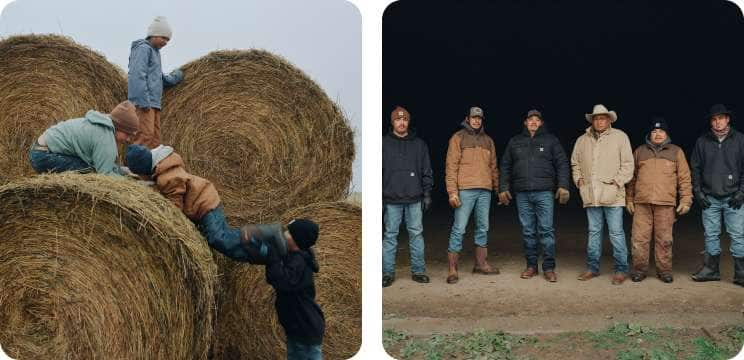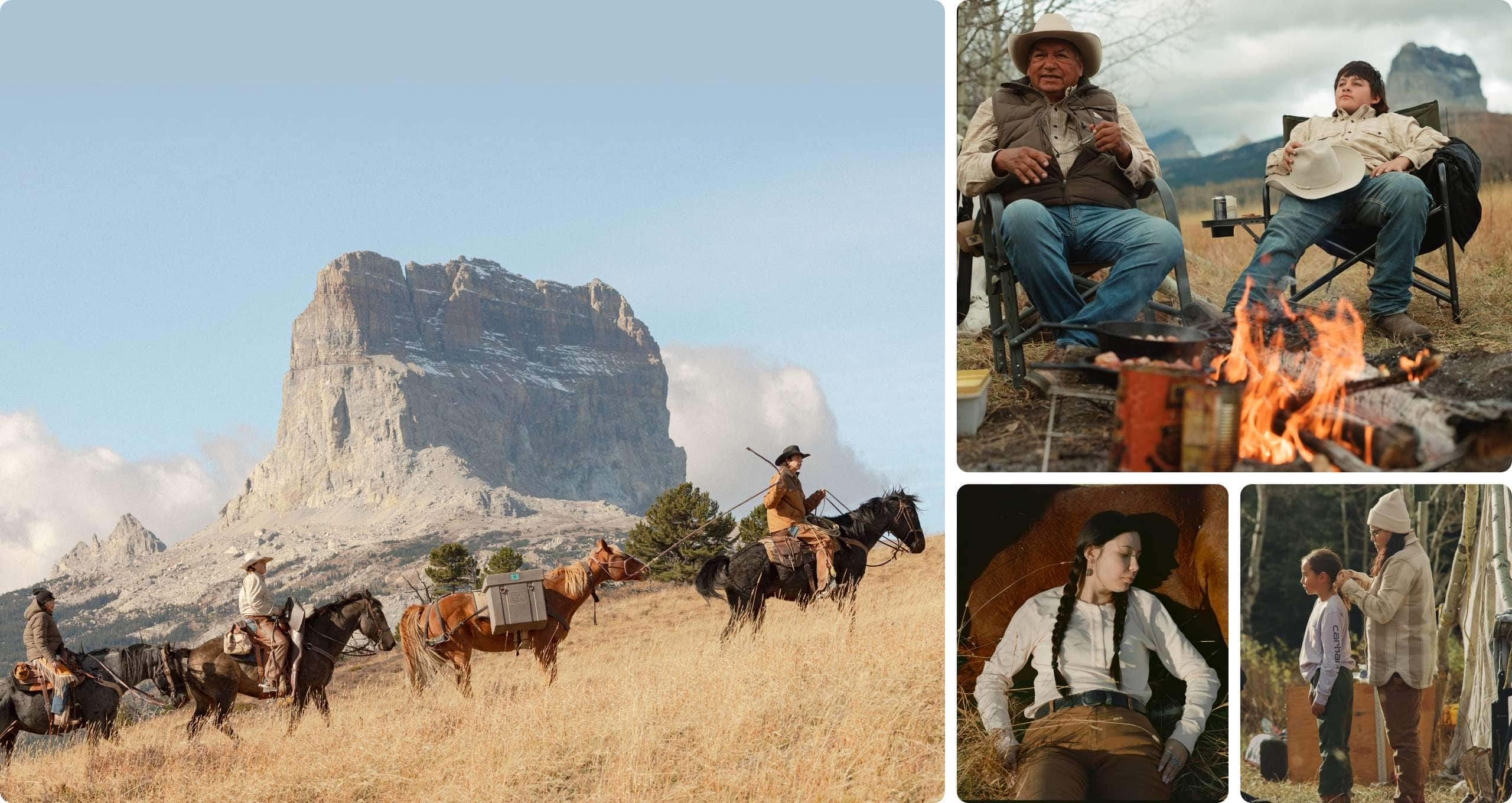

October 30, 2024
When The Buffalo Return
In February of 2022 we traveled to Browning, Montana, searching for real cowboys of the West. What we discovered is a story of legacy, family, and perseverance that needed to be told. A story so captivating that we returned to Browning almost two years later to witness its conclusion. This was the story of the Blackfeet Nation and their journey to bring buffalo back to their sacred land.
Over 150 years ago, the buffalo were victims of a mass slaughter that nearly eliminated their kind from the country. Today, they roam over 500 head strong on Blackfeet land. We followed the Carlson and Racine families to learn more about what it took to make this historic return possible and how it strengthened the bond between their families and their communities.


PART I: THE BUFFALO SKULL
In 1996, Ervin Carlson started working for the Blackfeet Tribe as the Agricultural Director. At the time, the Tribe had a very small herd of around 20 buffalo that were under the care of the Fish and Wildlife Department. Shortly after Erv started as Agricultural Director, the tribe decided to move the buffalo under Erv’s direction. Erv admits that he had a lot to learn at first. “I didn’t know anything about buffalo because they had been gone from us for so long,” he says. However, very quickly, Erv began to reform his connection with these animals. Bringing more buffalo back to Blackfeet land became his passion. With his newfound enthusiasm for the buffalo, and their return to Blackfeet land, Erv became the president of the InterTribal Buffalo Council. He has been president for over 20 years now.

Way back years ago we were out riding horseback, and it was late in the evening getting close to sundown, and there was a washout, and there was something white down there. I got off my horse and dug it out and it was a buffalo skull. I didn’t think anything of it, but I think back now, and that’s kind of where all of this started.
Ervin Carlson
PART II: A SEVERED CONNECTION
Erv’s passion for bringing these animals back to Blackfeet land wasn’t shared by everyone at first. Many thought it was a waste of time and resources as the reservation had other problems that needed to be solved. It was a slow process and at times Erv thought about giving up. It was only his newfound connection with the buffalo that kept him going. He knew that this spiritual connection was real, and that if he could bring these animals back, he could restore a part of Blackfeet culture that had been lost. The return of buffalo could help rebuild Blackfeet religion, language, and not only increase the health of their ecosystem, but strengthen their connection to the land as well.


There are a lot of things in our history that have been taken from us — buffalo is one of them.
Part III: FULL CIRCLE
For Erv and the Buffalo Council, it wasn’t enough to bring back the buffalo to their nation; they wanted to find buffalo with a bloodline that could be traced to those that once roamed Blackfeet land. Historical records show that in the late 1800s, before the Blackfeet had issues with their buffalo population, Blackfeet tribal members sold buffalo calves to the Canadian government. Many of these buffalo ended up in Elk Island National Park outside of Edmonton, AB.
As history unfolded and the buffalo were eradicated, the unfortunate truth was that the only buffalo with known association to Blackfeet land were the ones that had been sold off of it. In 2016, with the help of the Canadian Government and Elk Island National Park, Erv was able to travel north and work with some of these specific buffalo during the winter months. This is where he says he finally witnessed the true power of these animals. On the final day of his journey to meet his long-lost ancestors, he stood in the pen with them reflecting on 20 years of work and he finally understood, “I had met a lot of people, done a lot of work, and it just made me realize that it wasn’t me doing all of that, making all of that happen, it was the buffalo.”
In the end, not only was Erv able to rekindle his spiritual connection with his ancestors, but he was also able to bring them back home. With the help of partners from the Wildlife Conservation Society and Elk Island National Park, Erv returned with buffalo whose lineage could be traced back to Blackfeet land.
This was an incredible victory for Erv and all of Blackfeet Nation, but it was not the end. Erv had one goal still to accomplish: Release these buffalo into Glacier National Park where they could once again be a free-roaming herd, as they were so many years ago.


It just kind of hit me, these animals, they put themselves in storage for all these years, and when they felt it was time that we were ready, and they were ready to come back, they did.
PART IV: FAMILY BUSINESS
Erv would be the first to tell you that although he continues to work extremely hard to get more buffalo back to Blackfeet land, the real work is managing the herd. Under Erv’s direction, the herd has grown from around 20, to more than 500. This is an incredible achievement, but it means that there are now over 500 buffalo on their land that need to be fed, vaccinated, and protected. It’s a never-ending job that is managed by the Buffalo Council. They have a few cowboys on staff to help care for these animals, but the one who takes the lead is Chazz Racine, Erv’s grandson. In Blackfeet tradition, the first grandchild is often raised by their grandparents, and in this case, Erv raised Chazz as his own son. Chazz is in his 30s with kids of his own now, and he is raising them to understand the importance of the buffalo in their culture. Chazz and Erv know that if their nation is to truly reconnect with the buffalo on a spiritual level, the work will have to continue through the next generation.


This is more than just a job for Erv and Chazz. This is an opportunity to bring a fading culture back to life, and a chance to not only bring their people closer together, but their families as well. Ervin and Chazz keep their families invested in all of the work they do with the buffalo, from managing relationships with national parks to moving hundreds of buffalo from one area to the next. When they realized that their final goal was in reach, Erv and Chazz knew how important this would be for their families to witness. With that in mind, they took a trip as a family to the land under Chief Mountain, to camp out and understand where these buffalo would one day be roaming free. The family made offerings, said prayers, and prepared their sacred land for the glorious return of the buffalo.


My hope is that all the future generations can grow up to know the buffalo and have that connection with them. My grandkids, my great-grandkids and so on, to all be able to have that part of the culture that was taken from here.
PART V: THE RETURN
Over the last 20+ years, Erv and the members of the Buffalo Council have worked tirelessly to bring the buffalo back to Blackfeet Nation. However, the end goal was always to have the buffalo roam freely between Glacier National Park and Blackfeet land. It was never going to be easy, as they would have to work with the park and other partners to make it possible. After years of working through roadblocks, they were finally able to make this dream a reality. In June of 2023, the Blackfeet Nation partnered with Glacier National Park to release around 40 buffalo into the park. This is truly a momentous achievement for the Blackfeet Nation and all involved, but the work isn’t over yet. Erv and the Council plan to release more buffalo into the park in 2024 and will continue to do so until there are hundreds of buffalo that once again roam freely in their native land.


It was a really emotional and gratifying feeling that day. After all the hard work that we went through, that we finally had the animals out to our sacred area: Chief Mountain.
LEARN MORE: Intertribal BUFFALO COUNCIL
The InterTribal Buffalo Council (ITBC) is a collection of 83 tribes in 22 states. that facilitates the management of over 20,000 buffalo. ITBC members manage more than 32 million acres of Tribal lands, and have restored buffalo to nearly 1 million of those acres. From the large intact grasslands of Montana, to the small desert herds of New Mexico, ITBC is committed to reestablishing buffalo herds on Tribal lands in a manner that promotes cultural enhancement, spiritual revitalization, ecological restoration, and economic development. Membership of ITBC always remains open and there is a continued interest by non-member Tribes in joining the organization.
If you would like to learn more or donate to this mission, please visit: www.itbcbuffalonation.org.


Told by: Matt Cleary Photography: Elliot Ross Design: Joe Benghauser



